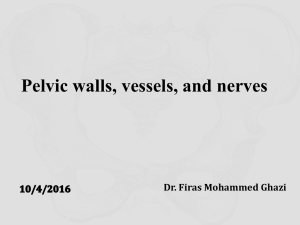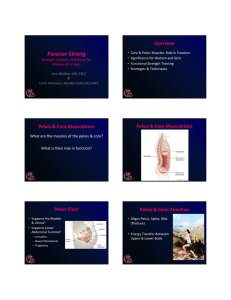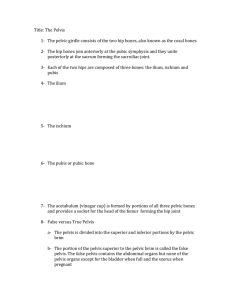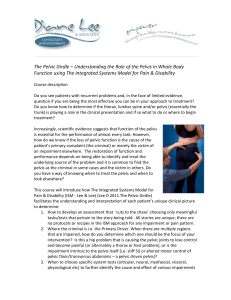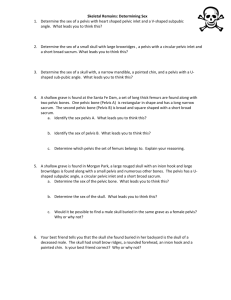Document 12481157
advertisement
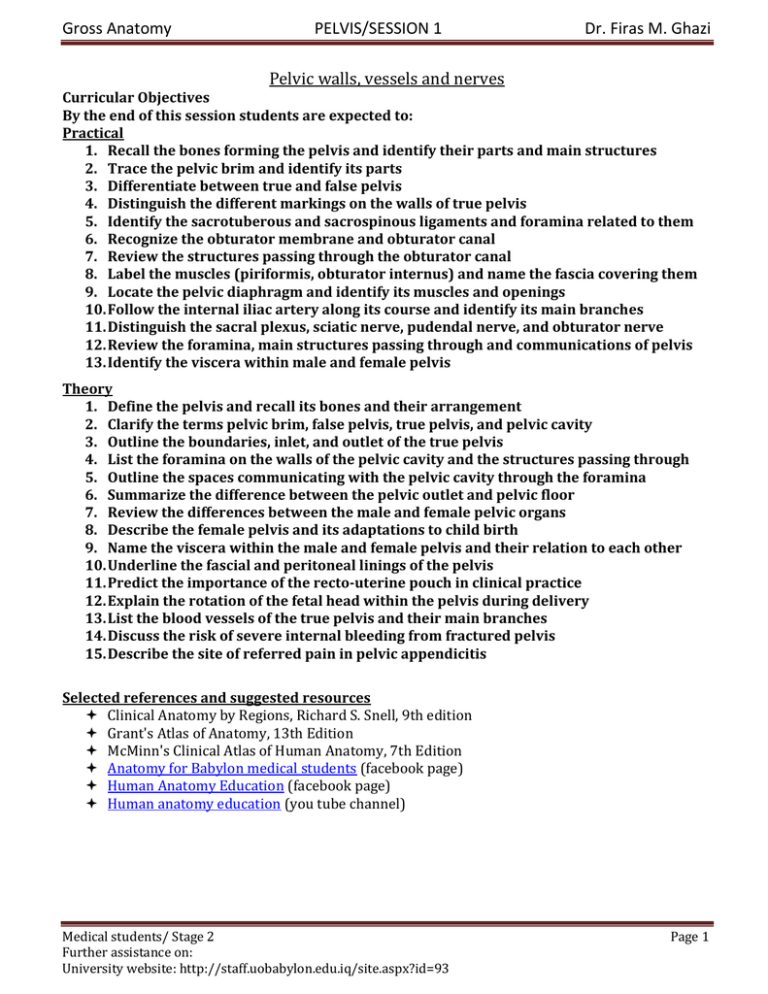
Gross Anatomy PELVIS/SESSION 1 Dr. Firas M. Ghazi Pelvic walls, vessels and nerves Curricular Objectives By the end of this session students are expected to: Practical 1. Recall the bones forming the pelvis and identify their parts and main structures 2. Trace the pelvic brim and identify its parts 3. Differentiate between true and false pelvis 4. Distinguish the different markings on the walls of true pelvis 5. Identify the sacrotuberous and sacrospinous ligaments and foramina related to them 6. Recognize the obturator membrane and obturator canal 7. Review the structures passing through the obturator canal 8. Label the muscles (piriformis, obturator internus) and name the fascia covering them 9. Locate the pelvic diaphragm and identify its muscles and openings 10. Follow the internal iliac artery along its course and identify its main branches 11. Distinguish the sacral plexus, sciatic nerve, pudendal nerve, and obturator nerve 12. Review the foramina, main structures passing through and communications of pelvis 13. Identify the viscera within male and female pelvis Theory 1. Define the pelvis and recall its bones and their arrangement 2. Clarify the terms pelvic brim, false pelvis, true pelvis, and pelvic cavity 3. Outline the boundaries, inlet, and outlet of the true pelvis 4. List the foramina on the walls of the pelvic cavity and the structures passing through 5. Outline the spaces communicating with the pelvic cavity through the foramina 6. Summarize the difference between the pelvic outlet and pelvic floor 7. Review the differences between the male and female pelvic organs 8. Describe the female pelvis and its adaptations to child birth 9. Name the viscera within the male and female pelvis and their relation to each other 10. Underline the fascial and peritoneal linings of the pelvis 11. Predict the importance of the recto-uterine pouch in clinical practice 12. Explain the rotation of the fetal head within the pelvis during delivery 13. List the blood vessels of the true pelvis and their main branches 14. Discuss the risk of severe internal bleeding from fractured pelvis 15. Describe the site of referred pain in pelvic appendicitis Selected references and suggested resources Clinical Anatomy by Regions, Richard S. Snell, 9th edition Grant's Atlas of Anatomy, 13th Edition McMinn's Clinical Atlas of Human Anatomy, 7th Edition Anatomy for Babylon medical students (facebook page) Human Anatomy Education (facebook page) Human anatomy education (you tube channel) Medical students/ Stage 2 Further assistance on: University website: http://staff.uobabylon.edu.iq/site.aspx?id=93 Page 1 Gross Anatomy PELVIS/SESSION 1 Dr. Firas M. Ghazi Lab identifying checklist 1. Bones and bone markings: Hip: Ilium, ischium, pubis Iliopectineal line, pelvic brim Ischial spine, ischial tuberosity Superior and inferior ramus of pubis, pubic arch, subpubic angle, pelvic outlet Sacrum: Sacral promontory, ala of the sacrum Coccyx True and false pelvis 2. Joints: sacroiliac, symphysis pubis 3. Ligaments: Sacrotuberous, sacrospinous 4. Muscles: Piriformis, obturator internus, levator ani, coccygeus 5. Foramina: Obturator foramin, obturator canal Greater and lesser sciatic foramina Anterior sacral foramina Urogenital hiatus Opening for the rectum (within pelvic diaphragm) 6. Vessels: Common iliac artery and vein External iliac artery and vein Internal iliac artery and vein Anterior and posterior divisions of internal iliac artery 7. Nerves: Obturator nerve Lumbosacral trunk Sacral plexus Sciatic nerve (root value?) Pudendal nerve 8. Pelvic viscera: Urinary bladder Rectum Uterus, vagina 9. Pelvic fascia, peritoneum, and perineal body 10. Pelvic spaces Rectovesical pouch Rectouterine pouch Uterovesical pouch Medical students/ Stage 2 Further assistance on: University website: http://staff.uobabylon.edu.iq/site.aspx?id=93 Page 2


